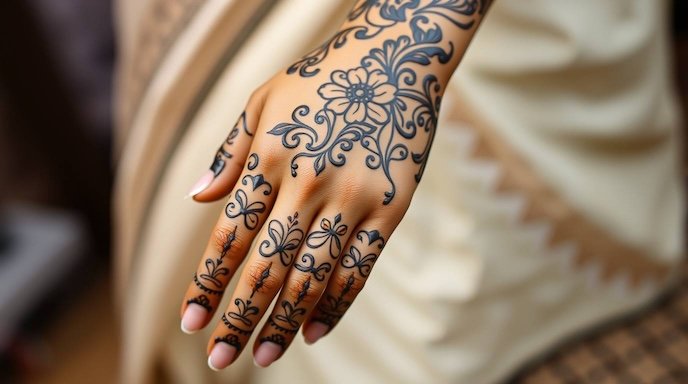Table of Contents
Introduction
Arabic full hand mehndi designs are captivating for their bold lines, flowing patterns, and elegant use of negative space. Many young people (including me and my friends) love to adorn our hands with mehndi for weddings, celebrations, and festivals. Unlike the dense, intricate patterns of traditional Indian mehndi, Arabic designs use a few large, impactful designs combined with plenty of skin left untouched. This creates a modern look that is trendy and rooted in traditions.
In this guide you’ll learn about Arabic full hand mehndi designs including its key features, techniques for drawing vines and bold outlines, and practical application tips. We’ll also explore popular variations, cultural symbolism, and creative customization ideas.
Be sure to scroll all the way to the bottom of the article as we show dozens of designs from our catalog throughout the article.
If you’re interested in other mehndi options then check out our articles on Arabic Back Hand Mehndi Designs and Arabic Peacock Mehndi Designs. For a high level overview see our article on Arabic Mehndi Designs.
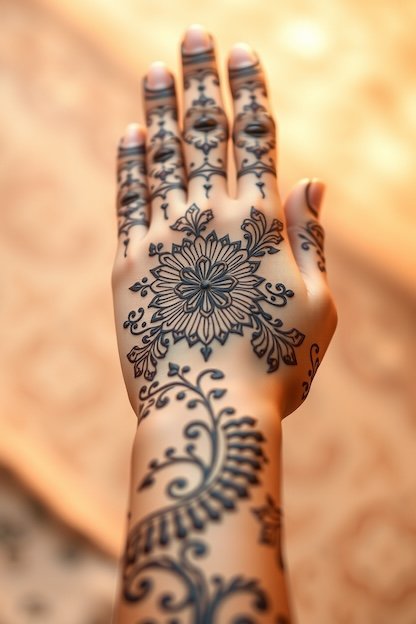
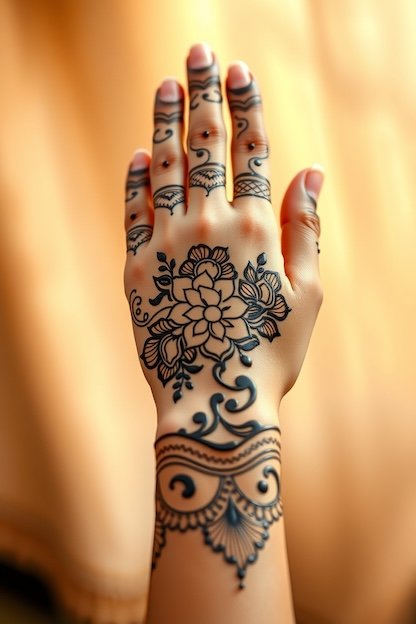
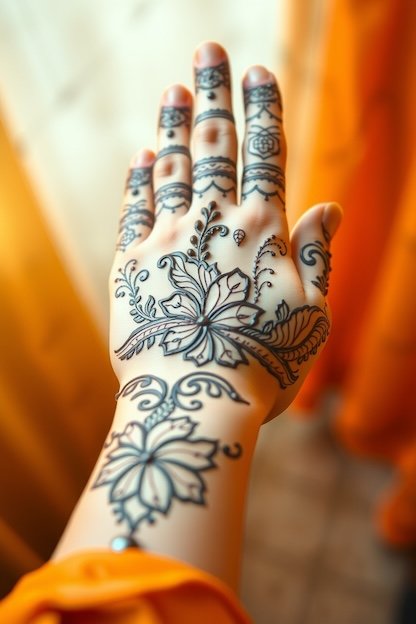
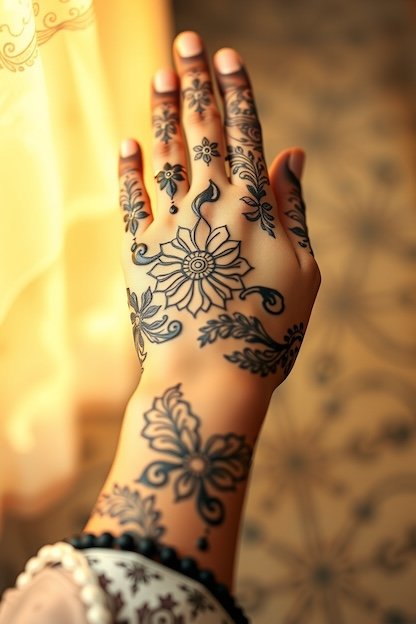
Background & Key Characteristics
Arabic mehndi designs originated in the Middle East and are now popular in India for their distinct style. These designs are distinct for several reasons. They feature bold, sweeping Arabic outlines that define each motif with confidence. Unlike densely filled Indian mehndi, these designs incorporate generous negative space. These are intentional gaps that allow the skin to show through. This not only highlights the large floral and paisley shapes but also gives the design a modern, minimalist appeal.
Key characteristics of Arabic Full Hand Mehndi Designs include:
- Large, Prominent Motifs: Typically, a big flower or paisley is used as the centerpiece.
- Flowing, Diagonal Layout: Rather than symmetry, Arabic designs often follow a diagonal or cascading flow across the hand.
- Emphasis on Contrast: The bold outlines contrast with open areas, creating visual drama without overwhelming detail.
- Ease of Modification: Because the designs use fewer, larger elements, they can be easily adapted for different occasions—be it a casual outing or a festive celebration.
These features not only make Arabic full-hand mehndi faster to apply but also give it a refined, uncluttered appearance that resonates with young trendsetters who appreciate both tradition and modern style.
Below are some samples of Arabic Full Hand Mehndi Designs, featuring a rose pattern, from our collection. Click the image to expand it and print a copy that can be used as a pattern. These probably wouldn’t be recommended for a beginner to try, but they can be used as inspiration. Use them to create something unique and beautiful for you.
Continue reading below to see examples of simpler patterns that you might like.
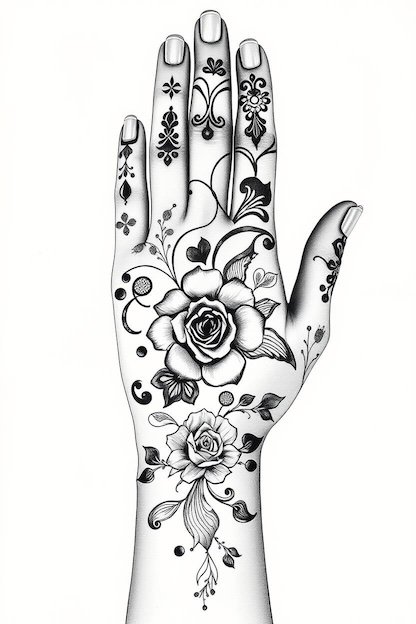
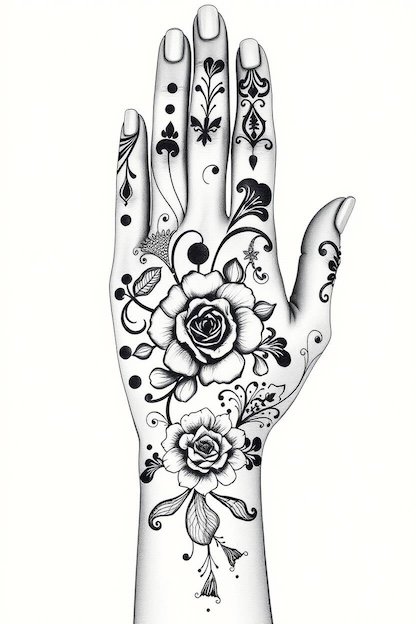
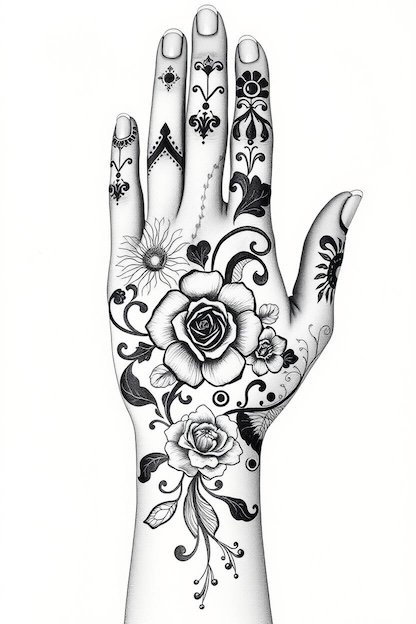

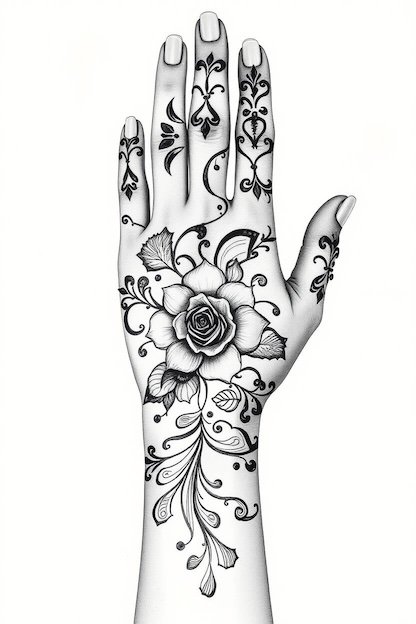
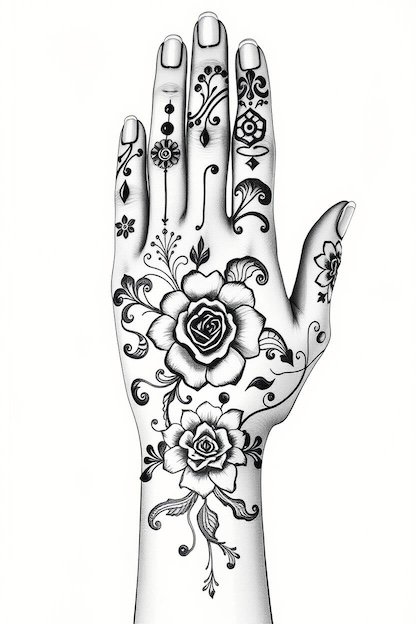
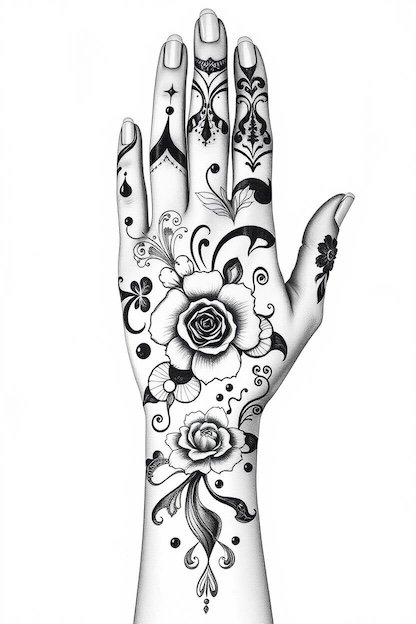
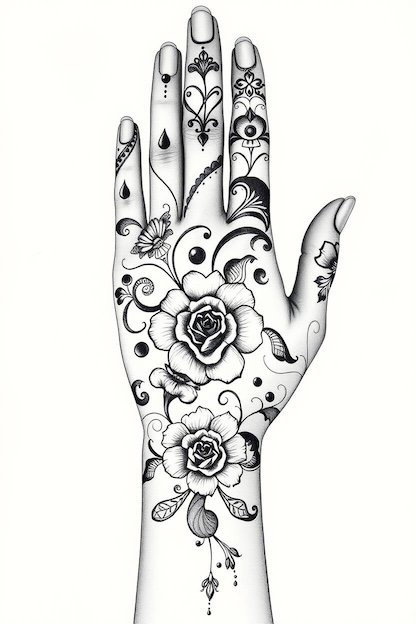
Design Elements & Techniques
Creating a cohesive full-hand Arabic mehndi design involves a balance of bold motifs and fluid connections. Here are the essential techniques and tips:
Planning the Layout
Start by visualizing the design’s flow over the hand. Many artists plan a central focal point such as a large flower on the back of the hand then extend vines toward the fingers and wrist. Lightly sketch guide lines on the skin if needed. Mapping key points helps avoid overcrowding and ensures balanced distribution of motifs.
Bold Outlines & Main Motifs
Arabic designs rely on confident, thick outlines. Use a high-quality henna cone to draw your main shapes:
- Big Flower or Paisley: Draw a large, central motif with clearly defined petals or curves.
- Placement: Position this motif where it naturally draws the eye—often in the center of the back of the hand or palm.
- Consistency: Maintain similar pressure on the cone for uniform line thickness. If your lines spread as they dry, draw them a bit thinner initially.
Connecting with Flowing Vines
Once the main elements are in place, connect them with smooth vines:
- Sweeping Vines: Draw gentle, curved lines that extend from one motif to another, following the natural contours of the hand.
- Leaves and Accents: Along these vines, add simple leaves or small buds. These embellishments should be drawn with a finer line to complement, not overpower, the main design.
- Negative Space: Ensure that while vines connect the larger shapes, ample gaps are maintained to create the signature negative space of Arabic designs.
Geometric and Finger Detailing
Arabic mehndi may incorporate subtle geometric patterns:
- Geometric Accents: Use small zig-zags or parallel lines sparingly as accents. Place them near the wrist or as a band across a finger.
- Finger Designs: Often, the fingers are decorated with minimal motifs. For example, a small flower or a simple vine on the tip of each finger can add an elegant finishing touch. Keep these elements delicate to ensure they balance with the bolder design on the palm.
Tips for Precision
- Steady Hand: Rest your drawing hand’s side or pinky on a stable surface to improve line control.
- Consistent Flow: Draw lines in one continuous motion where possible. Avoid abrupt stops by planning your strokes in advance.
- Practice on Paper: Before applying on skin, practice your motifs on paper to get comfortable with your design’s scale and flow.
- Use of Tools: Have a cotton swab or toothpick ready to correct small mistakes while the henna is still wet.
By combining these techniques, you can create Arabic full hand mehndi designs that are both striking and balanced. They use bold lines and spacious negative areas to highlight the beauty of each design element.
Below are some samples of Arabic Full Hand Mehndi Designs featuring long floral patterns that can be drawn from the tip of your fingers up your arm past the wrist. These are also taken from our collection. Click the image to expand it and print a copy that can be used as a pattern. Use the designs as they are drawn or they can be used as inspiration for you to create something unique and beautiful for yourself.
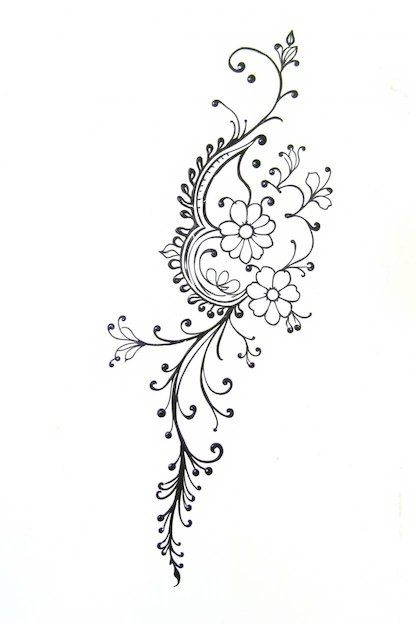
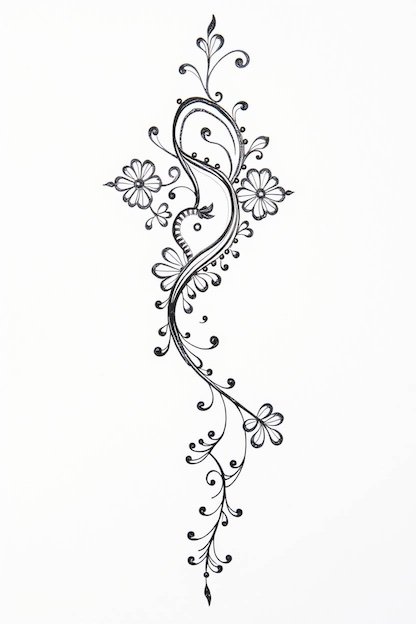
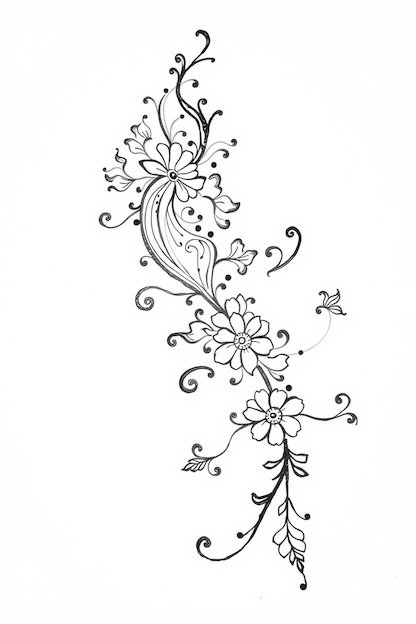
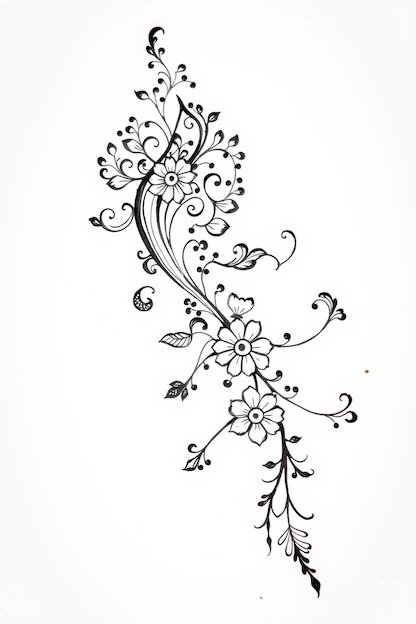
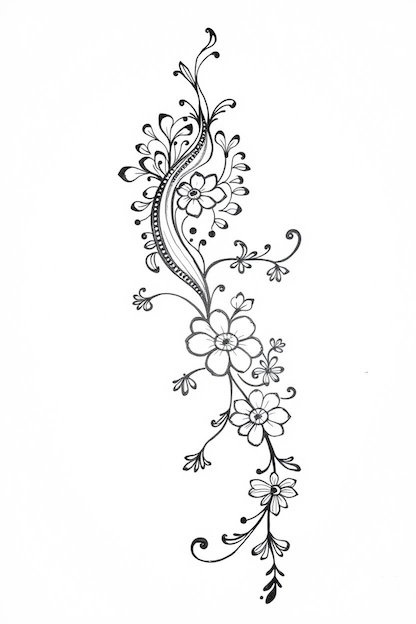
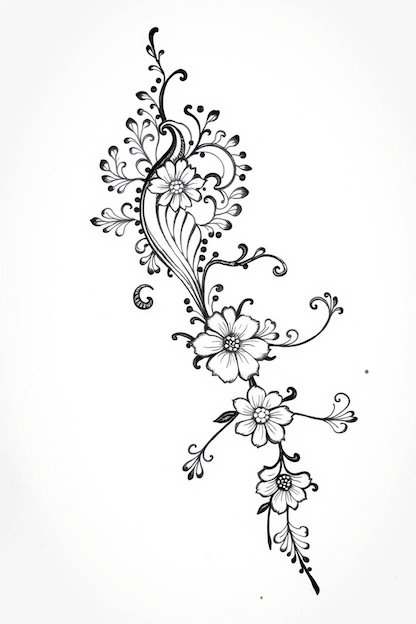
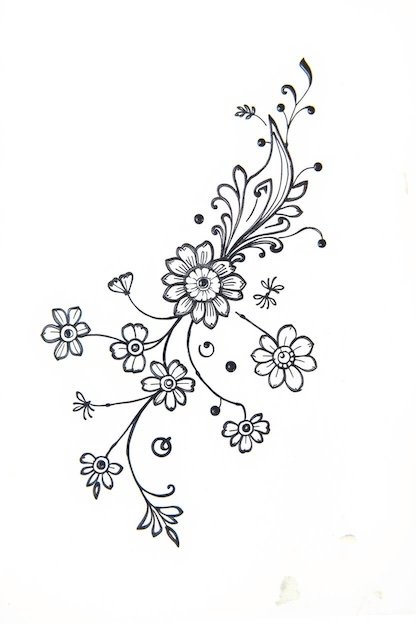
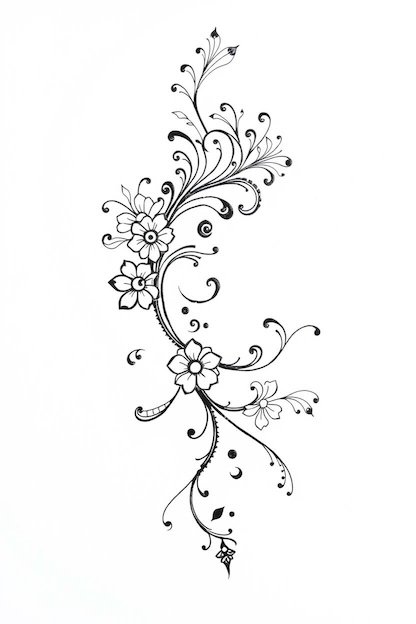
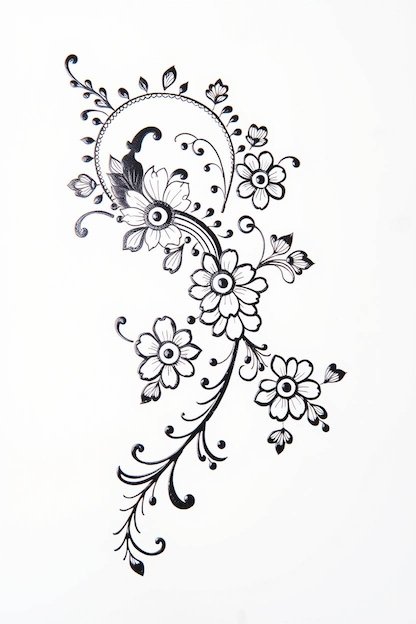
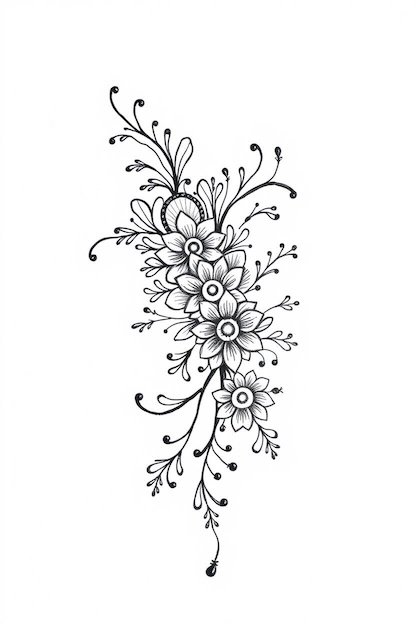
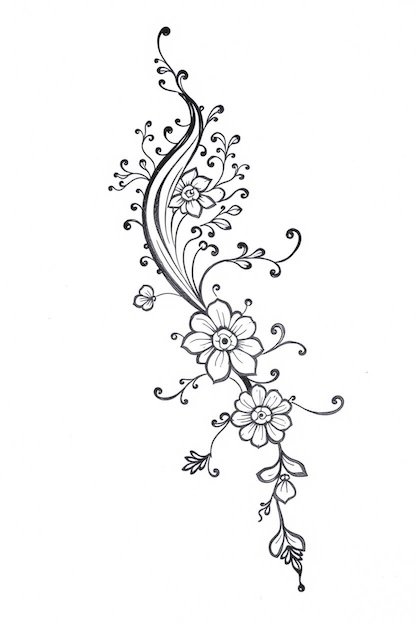

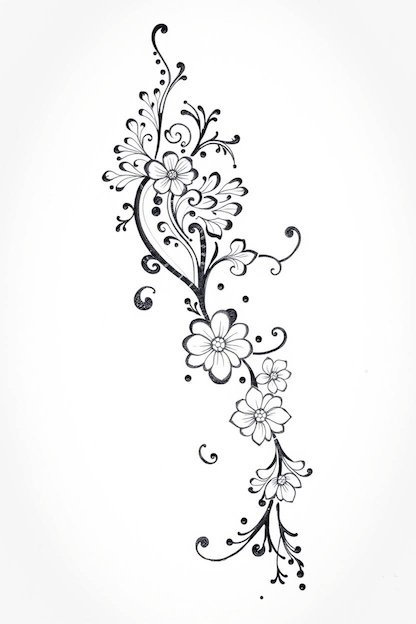
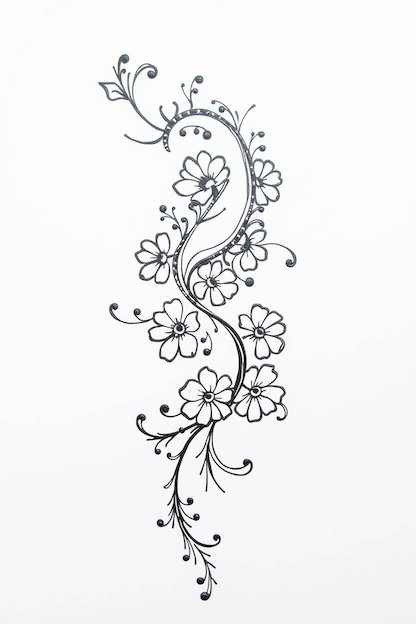
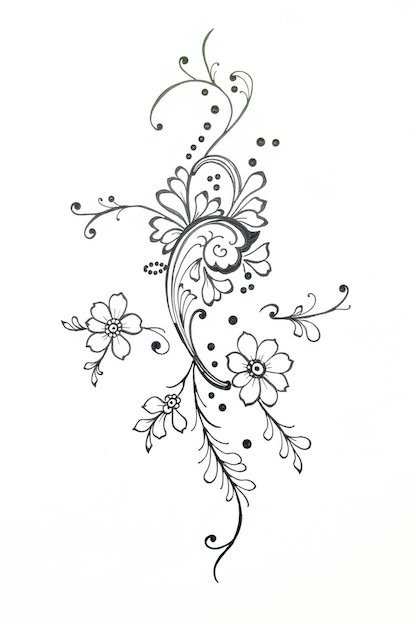
Step-by-Step Tutorial
Below is a beginner-friendly, detailed guide to applying an Arabic full-hand mehndi design.
Step 1: Gather Materials and Prepare the Skin
- Materials Needed
- Fresh, natural henna paste in a cone (ensure smooth consistency)
- Tissues, cotton swabs, and a small bowl for a lemon-sugar solution
- Optional cosmetic pencil for light guide marks
- Skin Preparation
- Wash your hands thoroughly; remove any lotions or oils.
- Dry completely to allow the henna to adhere well.
- If working on someone else, ensure they are seated comfortably with good lighting.
- Plan the Layout
- Mentally divide the hand into sections (wrist, palm, fingers).
- Lightly mark guide lines if needed, noting where your main motifs will go.
Step 2: Outline the Major Motifs
- Begin with a Focal Point
- Draw a large flower or paisley on the back of the hand or central palm. Use steady, bold strokes.
- Position this central motif so that it naturally anchors the rest of the design.
- Add Additional Anchors
- Place a secondary motif (such as a big leaf or small floral cluster) near the wrist or thumb area.
- Ensure these elements are spaced well to allow room for connecting vines later.
Step 3: Connect the Motifs with Vines and Swirls
- Drawing the Vines
- From the central motif, draw a sweeping vine that extends toward the fingers.
- Keep your hand steady by resting it on a flat surface.
- Adding Details
- Along the vine, incorporate small leaves or buds using finer lines.
- Repeat the process for each major motif, ensuring the design flows naturally.
- Maintaining Negative Space
- Step back frequently to check that you’re not overfilling; negative space is key in Arabic designs.
- Adjust by adding extra dots or small swirls only if a gap looks too harsh.
Step 4: Decorate the Fingers
- Finger Focus
- Decide whether each finger will have a unique mini design or a uniform pattern.
- Common ideas: a small flower at the fingertip with a short vine trailing down, or a thin band of henna near the nail.
- Consistency
- Keep the style consistent across all fingers. For example, if one finger has a delicate leaf, try a similar motif on the others.
- Practical Tips
- If doing your own hand, spread the fingers slightly and work one finger at a time to avoid smudging.
Step 5: Refine and Enhance the Design
- Final Touches
- Revisit any areas that seem too empty and add tiny details like dots or micro-motifs.
- Ensure smooth transitions between elements and that the overall balance is maintained.
- Optional Customization
- For a bridal or festive look, add a personal element such as a small initial or symbol integrated into the vine.
- Let It Dry
- Once the design is complete, allow it to dry undisturbed for at least 15-20 minutes.
- Lightly dab a lemon-sugar solution on the design to help the paste stay in place and enhance color uptake.
Step 6: Drying and Aftercare
- Drying
- Leave the henna on for at least 2 to 4 hours, ideally longer if possible. Many prefer to keep it on overnight.
- Avoid touching or smudging the design while it’s drying.
- Aftercare
- Once the paste is dry and flaking, gently scrape it off.
- Do not wash with water immediately; allow the stain to deepen over the next 24-48 hours.
- Apply natural oil (like coconut or mustard oil) to protect and enhance the stain.
- Extra Tips
- If any section appears too light, consider gently warming the area (for example, using a warm cloth) to deepen the stain further.
Following these steps will help you create a full-hand Arabic mehndi design that is both elegant and enduring. The process is as much about enjoying the art as it is about the final look.
Popular Variations & Trends
Arabic full-hand mehndi designs are not static. They evolve with trends and personal creativity. Here are some popular variations and emerging styles:
| Trend | Description |
|---|---|
| Contemporary Minimalism | Many young women are opting for a minimalist full-hand design with one or two large motifs and plenty of negative space. This look is clean, modern, and ideal for everyday wear or low-key events. |
| Fusion Bridal Styles | For weddings, there’s a trend to combine bold Arabic outlines with subtle, Indian-style fills. The result is a hybrid design that remains true to Arabic principles while offering extra detail for a richer look. |
| Finger-Focused Designs | In some modern variations, the main design is concentrated on the fingers, while the rest of the hand features simple, connecting vines. This approach is especially popular on social media for its chic, accessory-like appearance. |
| Jewelry-Inspired Motifs | Some artists add elements that mimic jewelry, such as bracelet-like bands around the wrist or small ring patterns on the fingers. These accents can be enhanced later with cosmetic glitter for a festive look. |
| Global Influences | With henna ideas spreading via Instagram and TikTok, many young artists are experimenting with creative twists like white henna outlines or mixing geometric patterns subtly with the traditional Arabic style. |
These trends highlight how adaptable Arabic full-hand mehndi is. It allows you to keep a core traditional look while adding a personal, modern twist.
Below are some samples of Arabic Full Hand Mehndi Designs featuring much more difficult patterns taken from our collection. These are not intended for beginners. However, with a little practice you’ll be drawing patterns like this very soon.
Click the image to expand it and print a copy that can be used as a pattern. Use the designs as they are drawn or they can be used as inspiration for you to create something unique and beautiful for yourself.
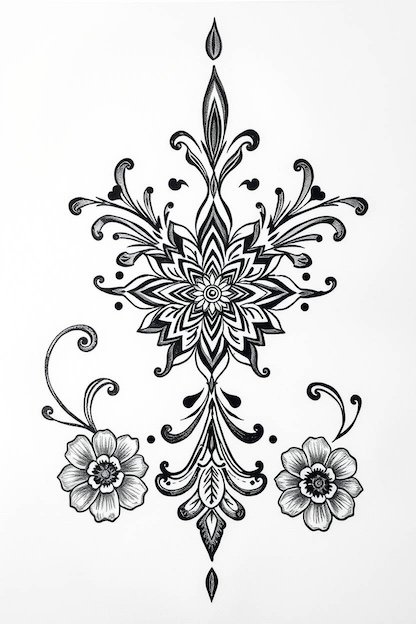
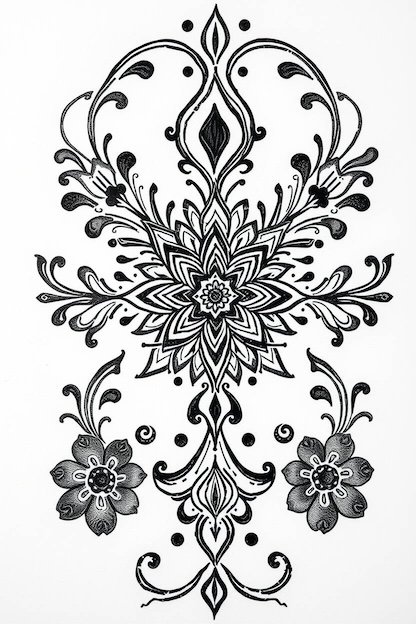
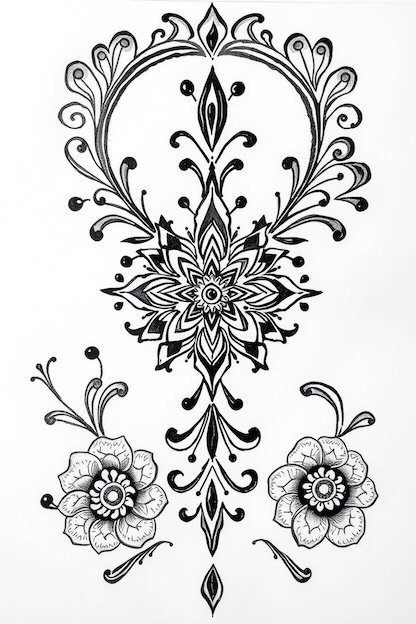
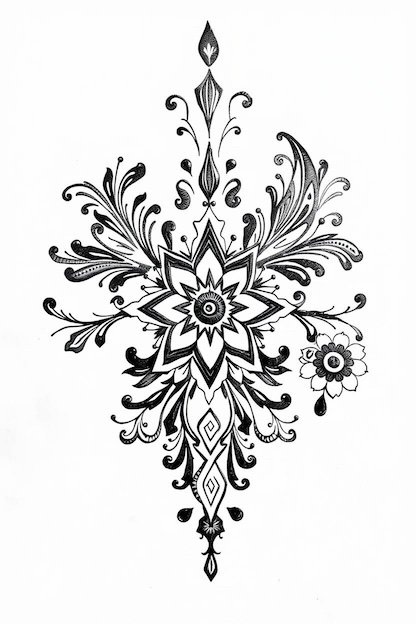
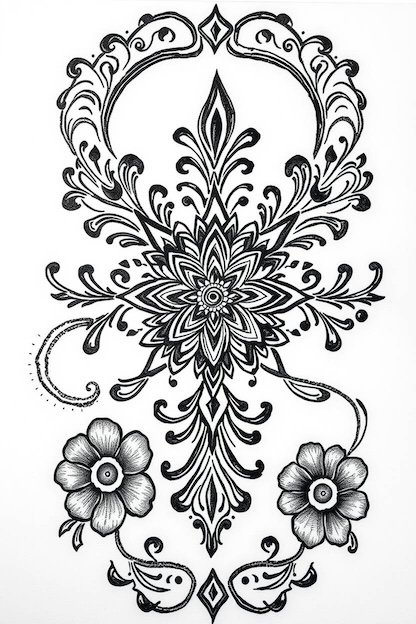
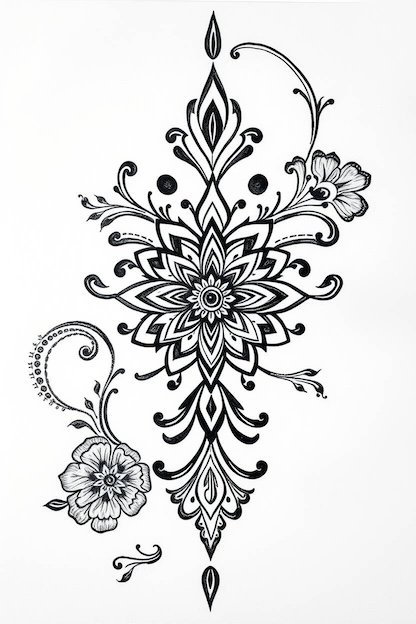
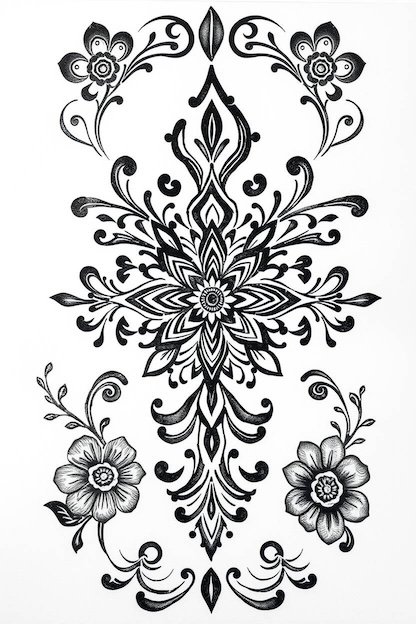
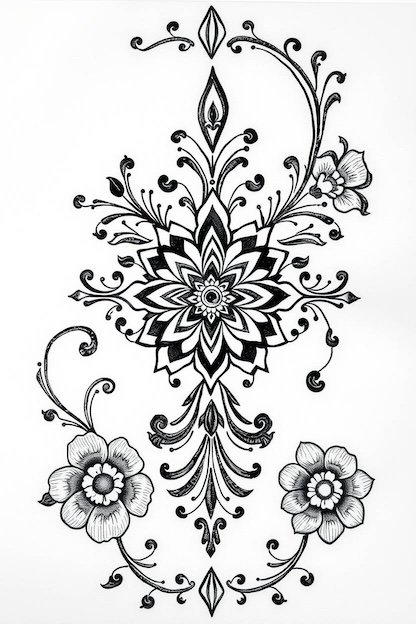
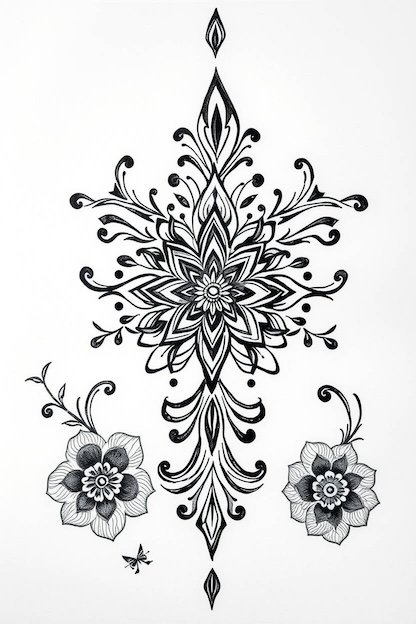
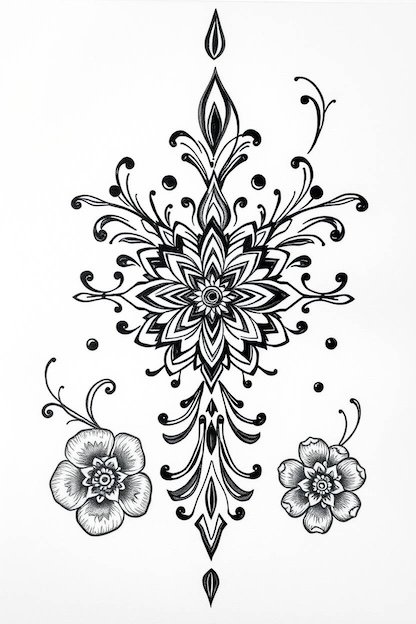
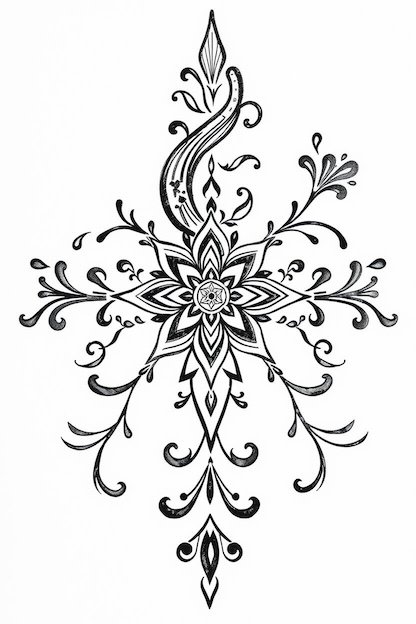
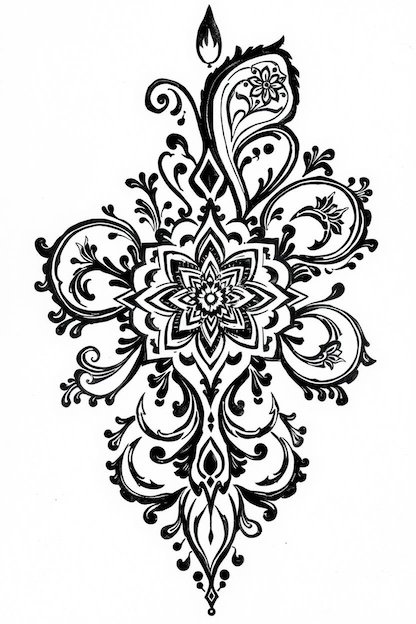
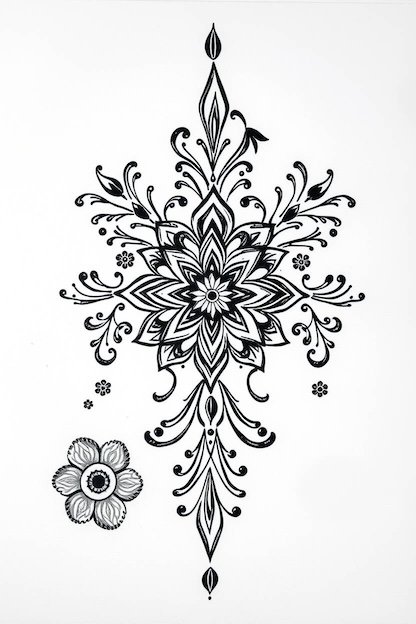
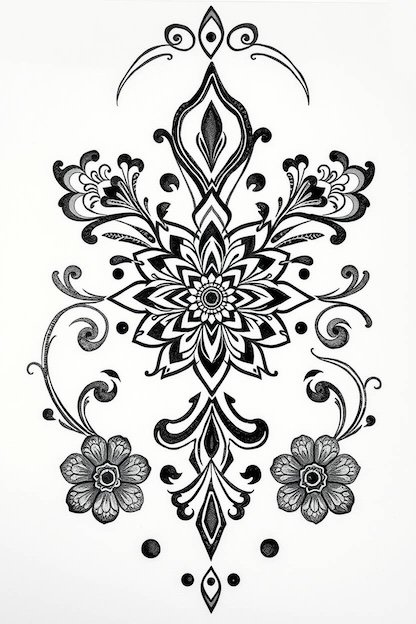
Cultural Inspirations & Symbolism
Arabic full-hand mehndi designs have a deep cultural meaning. In Middle Eastern traditions, henna is used to bless important occasions such as weddings and Eid, symbolizing beauty, protection, and prosperity. The bold motifs and expansive designs echo ideas of completeness and the journey of life, while each floral element, whether a large blooming flower or a small leaf, carries its own symbolism of love and new beginnings.
In Indian contexts, full-hand mehndi is equally cherished during weddings and festivals like Diwali, where it not only adorns the bride but also expresses joy and good fortune. These designs connect to a rich heritage that values beauty and blessing, making them both a personal statement and a cultural tradition. You can learn more about the cultural significance of Mehndi by visiting Cultural India’s page on Henna/Mehndi.
Creative Customization & Future Trends
Personalizing your Arabic full-hand mehndi design is part of its enduring charm. Here are some ideas for adding your unique twist:
Customization: Add subtle accents such as small initials or symbols within the design. For example, integrating a tiny heart or star into a vine can make the design uniquely yours.
Innovative Techniques: Experiment with varying line weights or use different applicator tips to create distinct textures. Some artists also try mixing in a little glitter (after the paste is off) to mimic jewelry.
Fusion Trends: Consider combining Arabic motifs with minimalistic geometric shapes or even a dash of Indo-Arabic detailing to create a rich yet uncluttered look. Social media is full of inspiring examples. Explore hashtags like #ArabicMehndi for fresh ideas.
Future Outlook: As digital platforms inspire new techniques, you might see more use of temporary white henna or even digital pre-visualization apps to plan your design. The beauty of Arabic mehndi lies in its versatility, allowing artists to innovate while staying true to its signature elegance.
These creative trends invite you to experiment, share your designs, and join a growing community that celebrates the art of henna.
FAQs & Common Misconceptions
Q: How are Arabic full hand mehndi designs different from other styles?
A: Arabic designs use bold outlines and large motifs with ample negative space, unlike the densely detailed Indian style. They are often asymmetrical and emphasize fluid, sweeping lines.
Q: Does Arabic mehndi last as long as traditional styles?
A: Yes. Longevity depends on henna quality and aftercare rather than the design style. With proper application and care, your design should last 1 to 2 weeks.
Q: Can beginners try Arabic full-hand designs?
A: Absolutely. The larger motifs and intentional negative space make Arabic designs more forgiving and quicker to apply—ideal for beginners.
Q: Is “black henna” used in Arabic designs?
A: No. Traditional henna produces an orange-brown to deep brown stain. Black henna often contains harmful chemicals and is unsafe. Always opt for natural henna.
Q: How do I ensure even coverage on Arabic full hand mehndi designs?
A: Plan your layout in advance, use consistent line techniques, and regularly step back to check for balance. Practice helps in managing the space effectively.
Conclusion
Arabic full-hand mehndi designs beautifully blend bold, flowing patterns with generous negative space for a look that is both modern and rooted in tradition. Whether for a wedding, festival, or personal expression, these designs offer a sophisticated yet accessible art form that resonates with young enthusiasts. By following the tips, techniques, and creative ideas outlined in this guide, you can confidently create a stunning, culturally rich design on your hand.
I hope this guide inspires you to experiment and make each design uniquely yours. Enjoy the process, embrace the art of henna, and let your hands tell a story of beauty and tradition.

